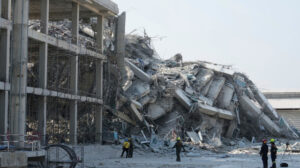More than 1,000 people have died in the powerful 7.7-magnitude earthquake that rocked Myanmar yesterday, Friday, with at least 2,376 injured and 30 more missing.
The earthquake in Myanmar also affected Bangkok although the Thai capital is 1,400 km away from the epicentre with seismologist and former director of the Geodynamic Institute, Aakis Tselentis explaining how this can also happen in areas of Greece in the event of an earthquake in the Greek arc, where the Eurasian plate collides south of Crete with the African plate.
As he explains, because of the very small focal depth of the Myanmar earthquake, a special category of seismic waves was created, surface waves, which have very long periods and propagate over the ground surface over very long distances.
Thus, even distant 7.5- 8.0R earthquakes can affect very tall buildings, large bridges, natural gas supply pipelines, wind turbines, and other large-scale structures in Greece.
Watch a video of how seismic waves move:
The post by Akis Tselentis
“Is our country at risk of similar LONG earthquakes that may, in the long run, occur in the Greek arc? (Where the Eurasian plate collides South of Crete with the African plate); Unfortunately, YES!”
The reason why skyscrapers fell in Bakong at a distance of 1400km away from the epicenter was mainly because the seismic waves that reached Bakong due to their long path through the earth’s crust lost the high frequencies stayed with the low frequencies (i.e. long periods) and shortened the buildings (the tall ones) that have long eigenperiods.
In addition, because of the very shallow focal depth, a special class of seismic waves was created, the surface waves, which have very long periods and propagate to the ground surface AT VERY LONG DISTANCES.
This should be of concern for Greece, because distant 7.5-8.0R earthquakes that are the potential of Hellenistic arc can affect very tall buildings, large bridges, gas supply pipelines, wind turbines, and other high period structures.
This explains why the earthquake of 81 mainly affected multi-storey apartment buildings in Athens and even the top floor above ,unlike the earthquake of 99 which hit mainly single-family houses that were not so well built and some apartment buildings of course but the damage occurred between the ground floor and the first floor and not on the last floors as in the earthquake of 81.
Remember also the 7ari from Kythera on Epiphany 2006. Where the whole country shook almost the same and even within Athens in tall buildings, bottles and various other small objects of composite fell even though they were more than 200 km away.

That is, the difference is that in such earthquakes we have a large low-level oscillation of the ground but not with great acceleration, unlike local and surface earthquakes that have large high-altitude ground motions and accelerations.
Ask me anything
Explore related questions





